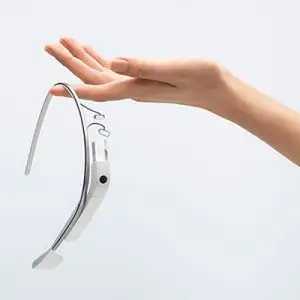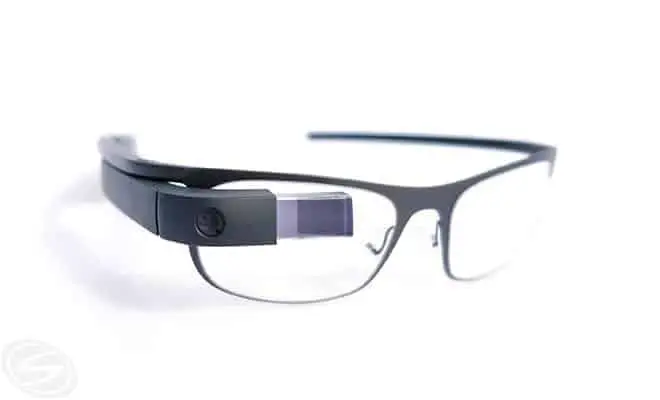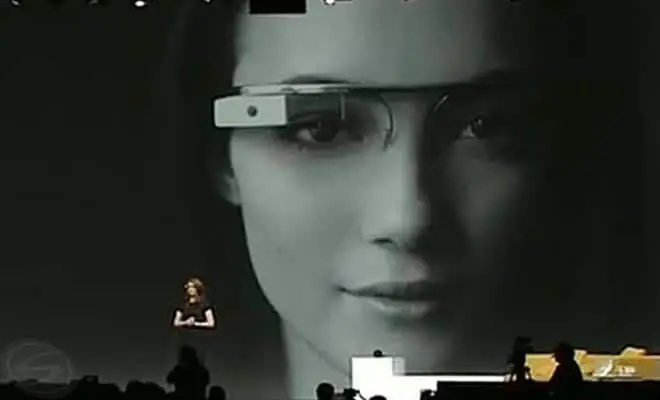Riding the rising wave of body-borne connected devices, Google Glass, the search engine’s smart glasses offering, is expected to become publicly available late in 2013. However multi-functional the final product turns out to be, Google Glass will surely stimulate endless creative ideas for application and implementation. Google is not alone in its desire to Borgify™ the masses. Rumors abound that Microsoft also plans an entry in this new category of wearable mobile devices. Some have suggested that a Redmond, WA entry might be called “Microsoft Monocles.” Since any of these devices will project an image to just one eye, such a monocle moniker might not be a bad idea. Meanwhile, Baidu, the Chinese search engine giant, suggests that it may join in the fray with the aptly named Baidu Eye. These smart glasses would include Mandarin voice recognition, although no production plans exist as of yet.
Miniaturization has been a godsend to the smart glasses movement. When it all began, in the early 90s, the user’s face was pretty much lost behind all the paraphernalia. Seven pounds of batteries were required to operate early prototypes, requiring battery packs to be worn on the hip or carried in bags. The time for bulky batteries has passed, with Google Glass establishing that weight and size is no longer an issue. However, cost may be. Developers paid nearly $1500 for early versions of the wearable computing smart glasses. Although a hefty sum, the sticker shock is somewhat softened among those wearing certain designer prescription eyewear already costing $500 or more. It has been rumored that Google may in fact subsidize the cost to bring regular production models down to approximately $750, although the details of such a subsidy have yet to be released.
An “early adoption” app competition already generated 4000 entries by April of 2013. At a South by Southwest Interactive presentation, Google showed off apps from Path, Evernote, Gmail and even the New York Times. The Gmail app was an obvious entry. It deftly uses voice commands to deliver the sender’s messages and replies.
The New York Times app will deliver a headline, byline, and time of posting. Tap your glasses, and they will read the article to you. The Evernote entry allows captured images to be easily shared to Skitch or Evernote. Updates to your Path network will be available, along with the ability make comments and add emoticons to the posts of friends.

Voice commands will initiate with the user saying “OK Glass.” Then, from a list of possible voice commands, the user will make a selection. Options will include directions, weather, searches, messaging, and recording – still or video. One will even enjoy the option of initiating a video-chat hangout. Google also promises on-the-go language translation. This feature alone could take haggling at a Turkish bazaar to another level.
Both Wi-fi and Bluetooth will be utilized to transmit images and text to the display, according to FCC filings. Bone induction technology transmit audio to your inner ear. This is a proven technology, although skeptics question whether the sound quality will be sufficient.
Battery life is expected to be approximately one day, although very specific information about this key issue has yet to appear. Google plans to initially offer the glasses in five colors: Sky, Charcoal, Shale, Tangerine, and Cotton. It looks like you’ll be able to color-coordinate them to your outfit from day one. And, although laser eye surgery and contacts have dramatically reduced the number of those wearing prescription glasses, Google promises a version of the product that can be used with one’s existing eyeglasses.
The Google Glass image is projected just above the viewer’s direct line of sight. The goal is to make driving directions, the time, etc, accessible without distraction. A still-life image projected there should be fairly easy to adapt to. However, what about movement? Even still images and text will appear, disappear, and change. Will this ever-changing landscape in one’s field of vision challenge concentration?
Smartphones already have many a conversation participant vigilant for evidence that they are being surreptitiously recorded. These glasses, with the built-in camera, threaten to take that paranoia to a whole new level. The declaration, “My camera is turned off — no really” will simply lack credibility. A bar in Seattle has already banned the glasses, months before they are to hit retail shelves. The owner suggested that wearers would simply “creep out” other patrons.

The “spectacle” of motorists wearing Google Glasses has generated some concern. Texting while driving has been the focus of intense legislative scrutiny, and now a West Virginia lawmaker has imagined a world of smart glasses wearing drivers, and he does not like what he sees. Rep. Gary G. Howell has introduced legislation that would ban the use of smart glasses behind the wheel in West Virginia. The feature that offers text and image projection in front of one of the lenses will invariably distract drivers, in Rep. Howell’s view.
One can “envision” these glasses being banned from the classroom as well. School uniforms were introduced in part to keep the well-heeled kids from showing off in their designer clothes. Wearing Google glasses would be unseemly in the same way. The greater problem would arise when the teacher says, “So Johnny, what is the square root of 625?” The fifth grader responds, “What is the square root of 625?” and the Siri-like voice recognition abilities of the device might result in the answer being rapidly projected in front of little Johnny’s eye. The school usage issue highlights a limitation, or at least a risk. If our student dons his glasses for recess, because he’d rather spend that time in a waterpark, and he gets whacked in the face by a stray basketball (or one that is not a stray), that pricey investment is toast. Still, Google promises that its new creation will be impact-resistant. Exactly how that phrase is to be defined remains to be seen.
Will Google Glass truly represent a truly disruptive innovation? Undoubtedly, Google is hoping that the term “OK Glass” enters tomorrow’s lexicon forthwith, joining the pantheon of new dictionary entries that this brave new internet age has engendered. The countdown has started, and the excitement is building as the late-2013 release approaches.
Source
Google Glass: [Company Website]

